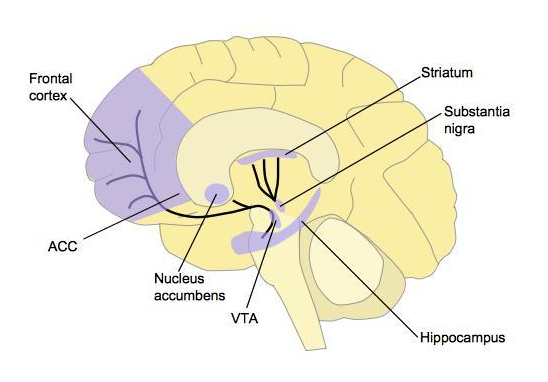Meditation brightens mood by pumping up dopamine levels
James KingslandAddiction, Anxiety, Attention, Biology, Buddhism, depression, Dopamine, EEG, Happiness, Health, Learning, Meditation, Mindfulness, MRI, Neuroscience, Psychology, science, Stress December 16, 2018
In an age of instant gratification and limited attention spans, why would anyone take up meditation? Perhaps for its soothing, stress-busting effects? Focusing on their breath or a mantra, even beginners start to notice the calming influence of their body’s “relaxation response”, the physiological flipside of the adrenaline-fuelled fight-or-flight response. Among other things the relaxation response slows respiration and heart rate, eases muscle tension and lowers blood pressure, and the changes are associated with a quieting of the brain’s “default mode network”, responsible for mind-wandering, rumination and worry.
But can that really be the whole story?
A peaceful mind is a wonderful thing and for many this is the biggest incentive to meditate regularly – not least for those of us prone to anxiety and depression – but there is another, related benefit that has received scant scientific or medical attention: meditation can be pleasurable, even ecstatic. In the Buddhist meditation known as jhana, for example, the early stages are characterised not only by feelings of peacefulness, but also joy and happiness.
It’s not difficult to see how this might motivate people to keep up their practice. One of the few studies to investigate the phenomenon found a 65% increase in levels of the neurotransmitter dopamine in a part of the brain called the striatum as people practised yoga nidra (a meditative state halfway between waking and sleep). As well as helping to control movement, dopamine release has been linked to every kind of pleasurable stimulus, from music, food and maternal love to humour, sex and money. Drugs of abuse such as cocaine owe their thrilling, addictive effects to their ability to commandeer the brain’s dopamine reward system.
In 2013, scientists led by Michael Hagerty at the University of California, Davis, demonstrated that meditation can activate our reward system in the absence of any drug or pleasurable external stimulus. Using EEG and fMRI (electroencephalography and functional magnetic resonance imaging), they monitored the brain activity of an expert meditator as he practised jhana, which involves focusing on the breath until a state of highly focused, undistracted “access concentration” is reached, followed by four progressively deeper jhana states.
The subject himself compared the first jhana to “continuous multiple orgasms”, the second to “opening a birthday gift and getting exactly what you most wished for” and the third to “postcoital bliss”. Unfortunately, the researchers were unable to obtain reliable readings from their equipment as the subject attained the first jhana because his head moved inside the MRI scanner, but during the second they recorded significantly increased activity in his nucleus accumbens, a key component of the brain’s dopamine reward circuit (see below).

Ecstatic altered states of consciousness are enjoyable while they last, but what have they got to do with liberation from suffering, the ultimate goal of Buddhist mindfulness and meditation practice? Or to put that in more modest, secular terms, what have they got to do with improved everyday mental health and wellbeing? Do meditative states that are less rarefied and more easily attained than yoga nidra or the jhanas also boost dopamine levels in the brain, and if so do any benefits spill over into ordinary consciousness?
The answers to these questions are a tentative “yes” and “yes”. Research published last month suggests that, as a result of increased baseline or “tonic” levels of dopamine in their brains, people who meditate may be less influenced by “negative reinforcement learning” (the way all kinds of setbacks and disappointments shape our behaviour) as they go about their everyday lives. And the longer they have been meditating, the stronger this effect appears to become. In other words, by boosting tonic dopamine levels, meditation may rebalance the way people respond to rewarding and punishing experiences, cushioning them against the painful blows that life invariably deals us.
Scientists are currently unable to monitor these subtle physiological and psychological effects while we work, read our emails, do the laundry, prepare dinner or any of the multiple other things that comprise a modern human’s day, but a psychology PhD candidate at the University of Surrey in the UK managed to measure them indirectly in the lab while subjects carried out a standardised learning task involving positive and negative reinforcements: the archetypal “carrots and sticks” that drive changes in our behaviour.
Paul Knytl recruited 35 people, roughly a third of them non-meditators, a third beginners and a third experienced meditators. The volunteers were wired for EEG – their scalps were plastered with electrodes – then asked to perform a screen-based learning task that involved picking the “winner” from pairs of Japanese hiragana characters, like the pair shown below. On average, out of six different symbols paired up in various combinations, three symbols were more likely to yield positive feedback (10 points awarded – a “carrot”), and three were more likely to yield negative feedback (10 points deducted – a “stick”). Later, to gauge how well participants had unconsciously learned these hidden probabilities, they were invited to choose between the same symbols based on their “gut feeling” alone, without any feedback being provided.

Overall performance on the learning task didn’t differ significantly between the three groups, but it turned out the experienced meditators were less likely than the other two groups to learn from negative feedback, as opposed to positive feedback. They responded to carrots but were less bothered by sticks. And the longer they had been meditating, the larger this “feedback learning bias” became. Importantly, the increasingly positive bias with greater meditation experience couldn’t be explained by any differences in age between participants.
When Knytl analysed changes in electrical activity in his subjects’ brains associated with performing the learning task, a possible explanation emerged. In learning experiments like this, when the difference between the EEG traces on negative and positive feedback trials is plotted, there is a characteristic peak that occurs about 250-300 milliseconds after feedback is delivered. This peak is called the FRN (Feedback-Related Negativity) and the smaller it is, the higher tonic levels of dopamine in the brain are assumed to be.
To understand why, it helps to know how dopamine signals reward in the brain. According to a leading theory of reinforcement learning, when an outcome is worse than expected, dopamine levels briefly plunge, making the associated behaviour or choice less likely in the future. When the outcome is better than expected, dopamine spikes, making that behaviour or choice more likely in future.* These are called phasic changes in dopamine because they’re transient. Crucially, the theory goes, if tonic or baseline levels of dopamine are already relatively high, it will take a larger negative reinforcement stimulus (a bigger stick) to get the same phasic dip in dopamine. Otherwise the threshold necessary for learning from negative feedback may not be reached. As a result, someone with high tonic dopamine levels will be less influenced by negative feedback and will have a smaller FRN.
On an emotional level, it may be that a person with relatively low tonic dopamine and a relatively large FRN will be more vulnerable to setbacks and disappointments. People who are suffering from clinical depression, for example, are known to have bigger FRNs than people without the condition. Even when they are in remission their FRNs are greater, suggesting they have an inbuilt learning bias that makes them more susceptible to punishing experiences.
Interestingly, patients with Parkinson’s disease (caused by impaired dopamine production) have a negative feedback learning bias when they are not taking the dopamine-boosting drug L-dopa. This may be what makes unmedicated Parkinson’s patients more prone to anxiety and depression. On their medication, this negative bias vanishes and is replaced by a positive bias. They become even more responsive to positive feedback than people without the condition, which may be what makes them so vulnerable to addiction.
Knytl speculates that meditative practices that involve focusing attention on a particular stimulus, repeatedly returning to it whenever the mind wanders, works like a virtuous cycle in the brain’s reward circuit that pumps up tonic dopamine levels. Like repeatedly exercising one group of muscles in the gym, meditation activates and bulks up brain networks involved in maintaining attention, such as the anterior cingulate cortex (ACC), prefrontal cortex and striatum. He writes: “What is striking about FAM [focused attention meditation] is that the cognitive processes invoked during practice bear close resemblance to the processes that the brain’s mesencephalic dopamine system and its target areas are thought to perform.”
In future studies, it will be important to establish the direction of causality of this apparent association between meditation and tonic dopamine. Are people with pre-existing high tonic dopamine levels more likely to be drawn to meditation, for whatever reason? Only prospective, controlled studies – following randomly selected subjects as they begin a meditation practice and comparing them with others who start doing something similar but different – will tell.
If this latest research suggesting meditation increases tonic dopamine can be confirmed, however, it provides a satisfying, physiological explanation for the efficacy of mindfulness-based therapies for preventing relapse in depression and helping people with addictions to resist their cravings. It adds to evidence that meditation really is an antidote for human suffering.
And there’s another sweet, tasty carrot dangling just out of reach of budding meditators. In his study, Knytl set the bar surprisingly low for inclusion in the “experienced meditators” category. To be included in this group, volunteers only needed to have been meditating for more than 30 minutes a week for the past four or more years. The vast majority of participants had less than five years’ experience. Yet the results suggested even this sustained but modest amount of meditation was pushing up their baseline dopamine levels. You could say it was working like a tonic.
Happy Christmas!
*An alternative theory proposes that dopamine, rather than signalling reward “prediction errors” per se, determines their precision.
